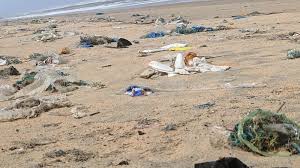Oct 3 – Goa’s beaches have become more polluted near the shores and more cleaner offshore in 2023-24 as compared to last year. Near shore Coastal Water Quality Index(CWQI) of the State reduced by nearly 7 points whereas the offshore index increased by 2 points as compared to last year, states the “EnviStats India 2024: Environment Accounts” report released by the Ministry of Statistics and Programme Implementation (MoSPI) on Sept 30 for 12 coastal states. CWQI of the Goa near the shore i.e. in waters less than one kilometer area near the shore, which was 53 points in 2022-23 has come down (more polluted) by nearly 7 points and stands at 46 points while the offshore index i.e. 5 Km and above away from the shore has increased from 65 to 67 in the year 2023-24, states the report. CWQI is an indicator to identify and assess periodical changes in seawater quality. The assessment is done through a collection of physical, chemical and biological samples on the beaches in coastal states. As per the report, CWQI score status for the past 3 years at shore(<1 Km), at nearshore(2 Km) and offshore(5 Km) are as follows – 2020-2021( shore 50, nearshore 52, offshore 55), 2021-2022( shore -, nearshore 58, offshore 54), 2022-2023( shore 53, nearshore 57, offshore 65) and 2023-2024 (shore 46, nearshore 53, offshore 67) . As per the index a CWQI score of 41 to 60 is considered moderate quality of water while a score of 61-80 is considered as good.
2 plants and 7 animals in Goa notified as threatened species
The report states that 2 plants and 7 animals have been notified in threatened species list under Section 38 of the Bio Diversity Act. Threatened species are species on the verge of extinction or likely to become extinct in the near future. The report also states that area under mangroves has increased from 22 sq km in 2013 to 27 sq km in 2021. In addition, as per the Species Richness Count of IUCN Red List of Threatened Species, the Amphibian count of the state has increased from 31 in 2022 version 2 list to 46 in 2023 version 1 IUCN list and reptile species have increased from 96 to 97. The count of Mamals at 108, mangrove at 20 and crabs at 5 have remained the same in both lists.



















